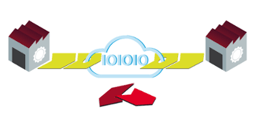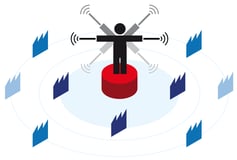Managing Sustainability and The Circular Economy
Hansjörg Tutsch - March 02, 2021
Everything we do as humans is dependent on our ecosystem and its resources. This includes businesses that consume significant amounts of natural resources to power operations, manufacture products, and deliver finished goods. With such considerable consumption, many companies take from our environment without giving anything back, resulting in a global climate crisis. This compromises our access to the resources we require to maintain our daily practices. As a result, companies' pressure to be a part of the solution, rather than the problem, is on. It is increasingly crucial that organizations recognize the importance of developing a circular economy, especially when managing a supply chain.
From Linear to Circular
A significant way to manage sustainability is by transitioning from our current linear economy, which is highly unsustainable, to a circular economy. Before we dive into this transition, we'll discuss the critical differences between these two economies. The traditional linear economy that we currently use moves in a line between three points; make, use, and dispose. The prominent issue with this system is that it requires organizations to produce new goods to replace the disposals continuously. Each time a supply chain manufactures a new product, it consumes more energy and resources, with the addition of waste from disposed goods.
Linear economies minimize the value of goods by only allowing them to have one life. Some companies may think this is good for business. After all, customers will have to buy more - isn't that the point of business? To answer this, you have to consider your organization's goals. While every company should strive for profit and success, there is a more defining goal: delivering value to your customers. In providing a product or service, you should aspire to deliver the highest possible quality to your customers, which should be a product with a long lifetime. In addition to minimizing product value, linear economies are detrimental to the wellbeing of the environment. The frivolous disposal of goods pollutes our ecosystem, affecting human health and wasting and compromising the resources needed to continue production. As a result, companies need to limit their consumption of limited resources, which can be done through recycling products and giving them a second life. This is where circular economies come in.
According to the United Nations International Development Organization (UNIDO), a circular economy "is a new way of creating value and ultimately prosperity." The circular economy “works by extending product lifespan through improved design and servicing and relocating waste from the end of the supply chain to the beginning – in effect, using resources more efficiently by using them over and over.”
To simplify that description, a circular economy is an alternative to linear, which entails keeping products in use for as long as possible. According to the UNIDO, humans consume 1.7 times the amount of resources the Earth can produce, and at the rate we are consuming, it is unsustainable. As a result of this, businesses must begin to reuse materials and products. This does not  necessarily mean using worn-out and broken products, but rather keeping products in use through various means, thus maximizing their value. Once a product is made and used, rather than disposing of it entirely, organizations can recover products to then reuse their materials into regenerated products. But, it doesn't stop there - recycling and reusing materials are only the tips of the iceberg. In addition to circulating raw materials, circular economies also focus on utilizing renewable energy sources, such as sunlight and wind, instead of fossil fuels that are costly and scarce. The circular economy system redefines sustainability for not only businesses but society as a whole. There are various ways to implement a circular economy within your supply chain, whether reusing your own materials and products or recycling them to another organization to distribute for reuse.
necessarily mean using worn-out and broken products, but rather keeping products in use through various means, thus maximizing their value. Once a product is made and used, rather than disposing of it entirely, organizations can recover products to then reuse their materials into regenerated products. But, it doesn't stop there - recycling and reusing materials are only the tips of the iceberg. In addition to circulating raw materials, circular economies also focus on utilizing renewable energy sources, such as sunlight and wind, instead of fossil fuels that are costly and scarce. The circular economy system redefines sustainability for not only businesses but society as a whole. There are various ways to implement a circular economy within your supply chain, whether reusing your own materials and products or recycling them to another organization to distribute for reuse.
If you are intimidated by this transition, we’ll give you a real example of an organization’s switch to a circular economy. This organization began with three primary objectives; encourage initiatives, develop innovation in the circular economy, and aim for a negative carbon balance by 2030. With these impressive goals in mind, they got to work and created the first Re-Factory, Europe’s first circular economy factory dedicated to mobility. Designed to extend the lifecycle of vehicles and their materials, this organization is a front runner in leading the supply chain industry towards a more sustainable future.
What’s in It for You
After understanding the key differences between a linear and circular economy, you may be thinking: yes, it's good for the environment, but what about the businesses making these changes? Transitioning to a circular economy offers many economic and operational benefits, which we'll discuss now. As was touched upon, a significant benefit to a circular economy is greater resource productivity. This means that your organization will be making better use of the resources you consume, maximizing their use. In turn, you will require less energy and resources, significantly reducing costs. With less dependence on resources such as fossil fuels, oil, and nuclear power, your organization will also achieve price stability, as your costs will not fluctuate based on such ![]() volatile resource prices. Sustainability will also help your organization minimize regulatory risks as you will be efficiently meeting environmental regulations and standards. Another significant financial benefit is the expenses saved through the reuse of materials. Using recycled products for materials, you will spend less on procuring new materials, saving your organization money while reducing waste.
volatile resource prices. Sustainability will also help your organization minimize regulatory risks as you will be efficiently meeting environmental regulations and standards. Another significant financial benefit is the expenses saved through the reuse of materials. Using recycled products for materials, you will spend less on procuring new materials, saving your organization money while reducing waste.
Additionally, you will be delivering a more competitive economy and equipping your organization with excellent competitive advantage. As sustainability becomes more and more integrated into the supply chain industry, your organization must be ahead of competitors by implementing sustainability first. As mentioned before, 88% of consumers reported that they are more likely to support brands they view to be more ethical and sustainable. In integrating sustainability, you will be significantly improving your brand image. Customers will see that your organization is environmentally friendly, so they will be more likely to purchase from you, feeling as though they are doing their part by choosing a sustainable organization. Your company's brand image is one of its most valuable intangible assets, so it is vital to keep up with future trends and get green.
Sustainability as a Result
Let's take it back to the beginning. In transitioning your organization to a circular economy, you are heading towards a more sustainable future. Now that you understand the value of striving towards a circular economy, we will discuss the best practices to achieving and managing one. First, to create a sustainable supply chain, you must map out your supply chain. This involves figuring out where the most significant opportunities for sustainability lie in your supply chain, whether it be practices, suppliers, or materials. This will allow you to pinpoint your most prominent areas of waste so that you can improve them. Next, you should set realistic expectations. If it were easy to switch to a circular economy, everyone would have done it by now – but it's worth the work. A simple place to start is determining the materials vital to your operations and determining where they end up once they leave your facility. This will lead you to plan how you can reacquire these materials and reuse them for future production.
With this, you should set baselines and KPIs to track your progress. This step is vital because you can't reduce what you don't measure. As supply chains are continually juggling KPIs, shipments, and productions, it may not seem manageable to implement more measurements. In a separate flexis blog on balancing carbon emissions against other supply chain KPIs, we provide the best practices in balancing these KPIs to help you achieve a more sustainable supply chain without compromising other vital factors in your organization. This includes setting attainable targets that allow you to track your progress in a variety of ways, in addition to implementing systems to translate metrics into data your organization will use. Targets could include a percentage by which you hope to reduce emissions or acquiring a set amount of materials for reuse.
Playing our part in this goal, flexis is working with 36 other partners in a plan for developing new concepts and services for the recycling industry. This plan relocates materials that are not of use to one company to another. With this system in place, organizations can ensure that they utilize materials to the absolute extent of their value, reducing further environmental damage. While it takes time and devotion with any long-term goal and managing sustainability is no exception, it is a cause worthy of the work. The remanufacturing market is booming, and it is time for your organization to get involved.
LATEST POSTS
- Understand Circular Economy in The Manufacturing Industry
- How Can Industry 4.0 IT Integration Be Achieved Smoothly?
- The Significance of Order Sequencing in Discrete Manufacturing
- How to improve your Supply Chain Management: The Power of Control Towers
- Optimizing Human Resource Scheduling in Manufacturing: A Technological Approach



